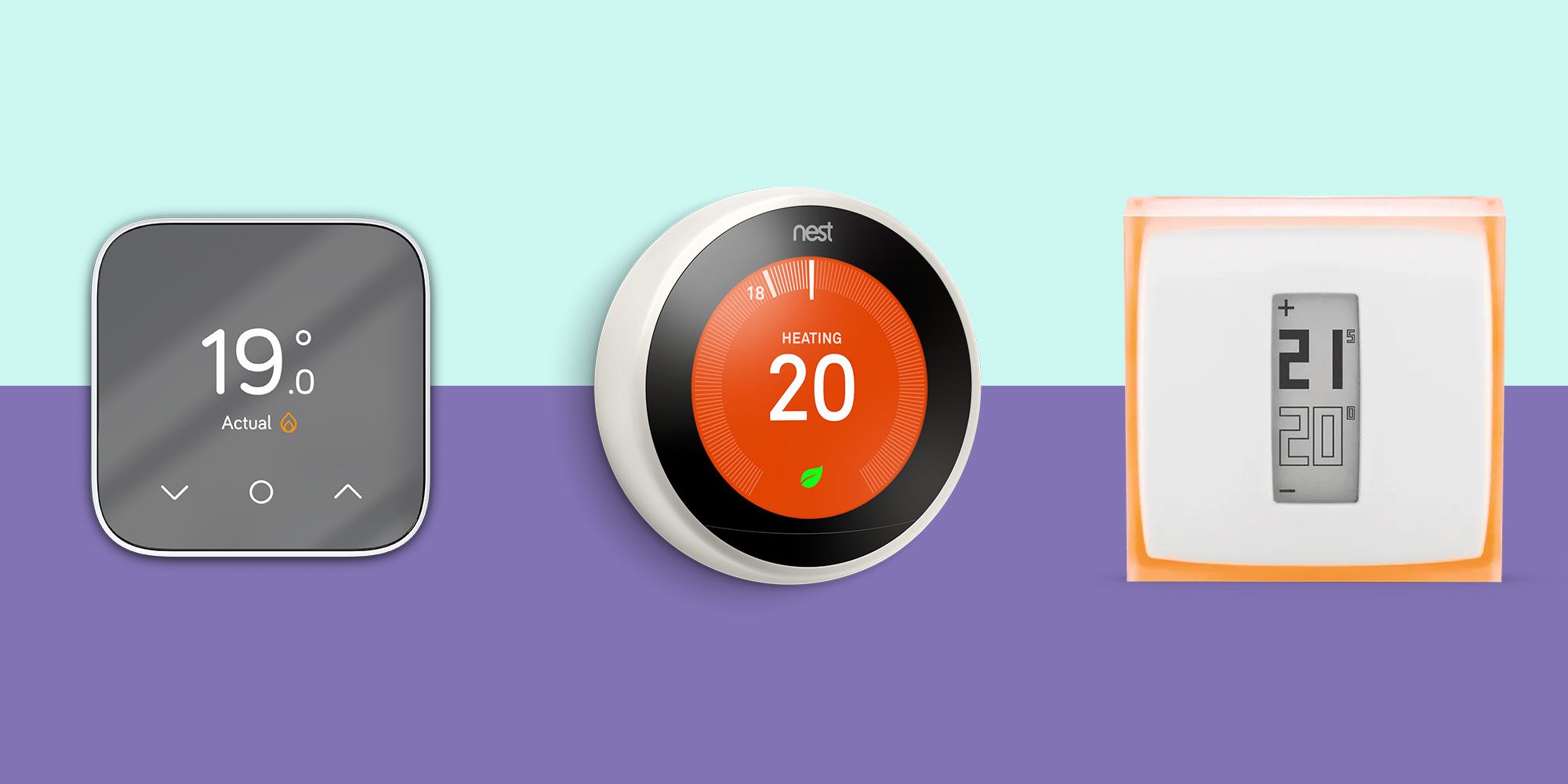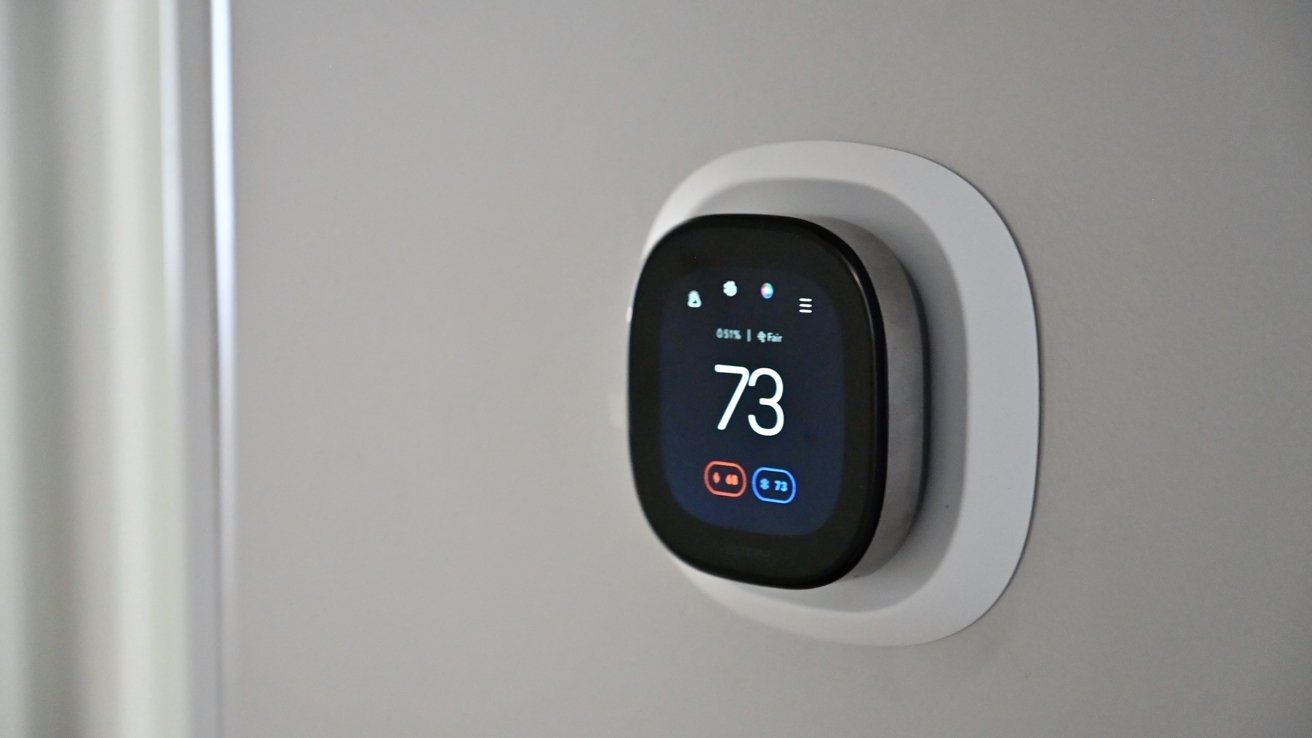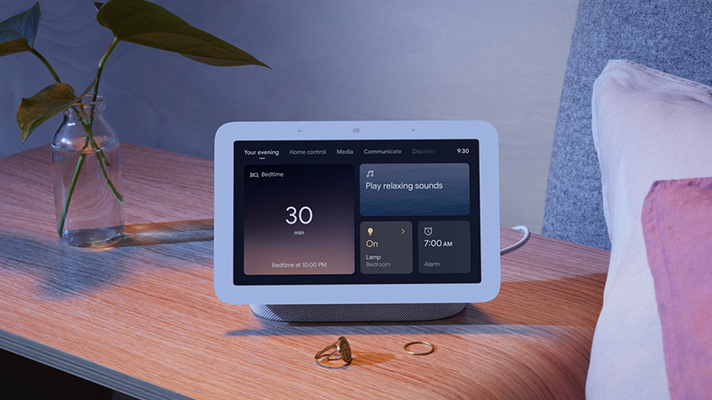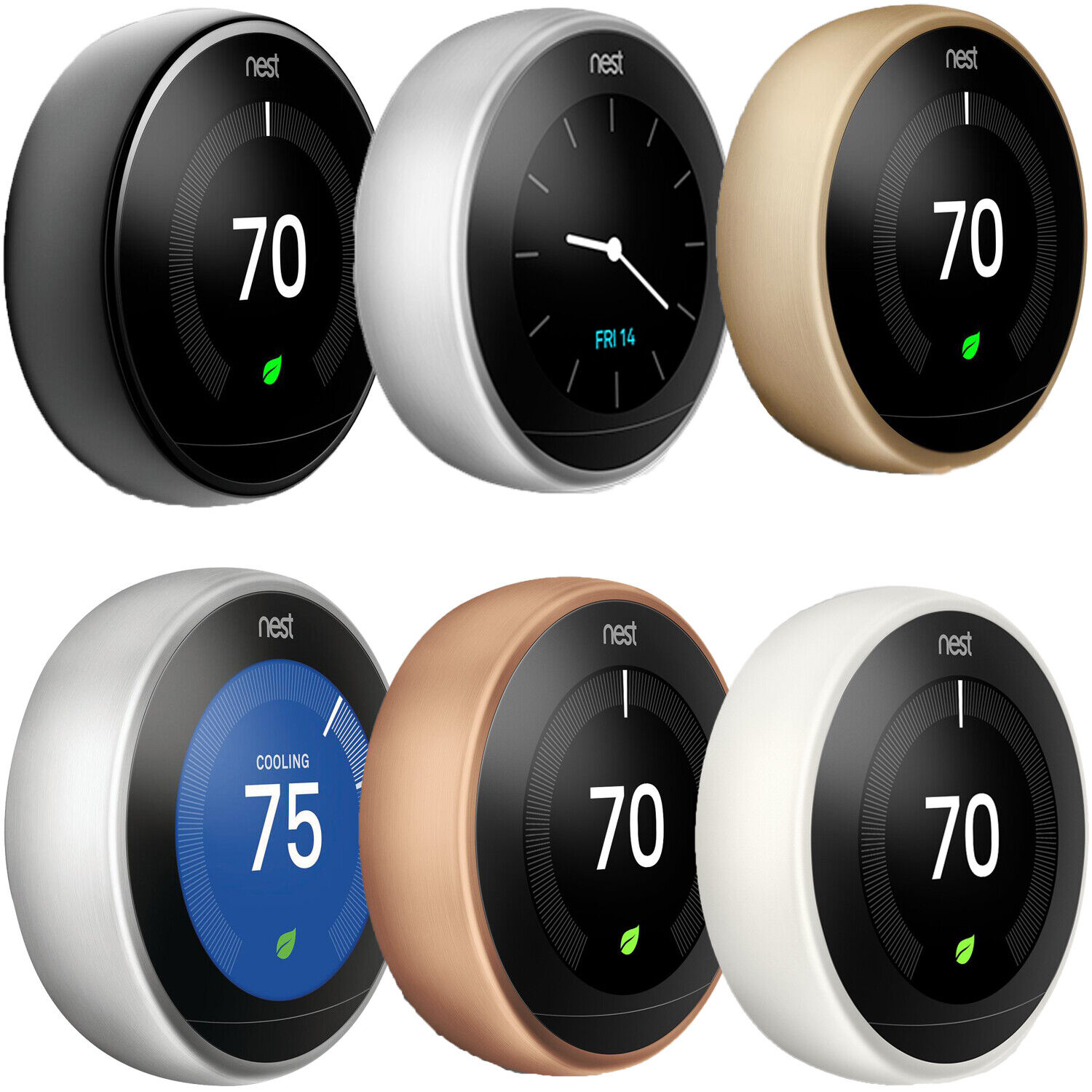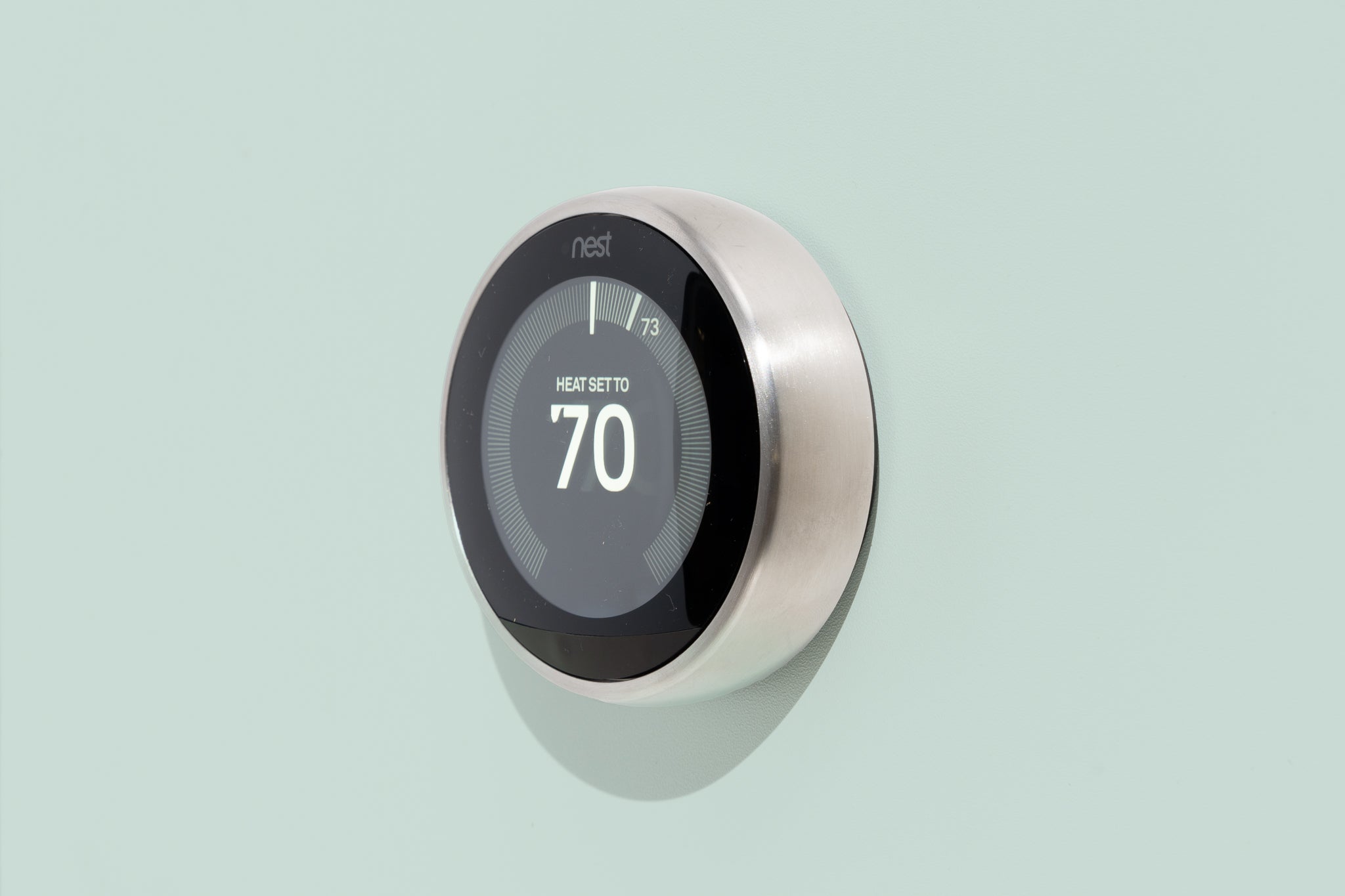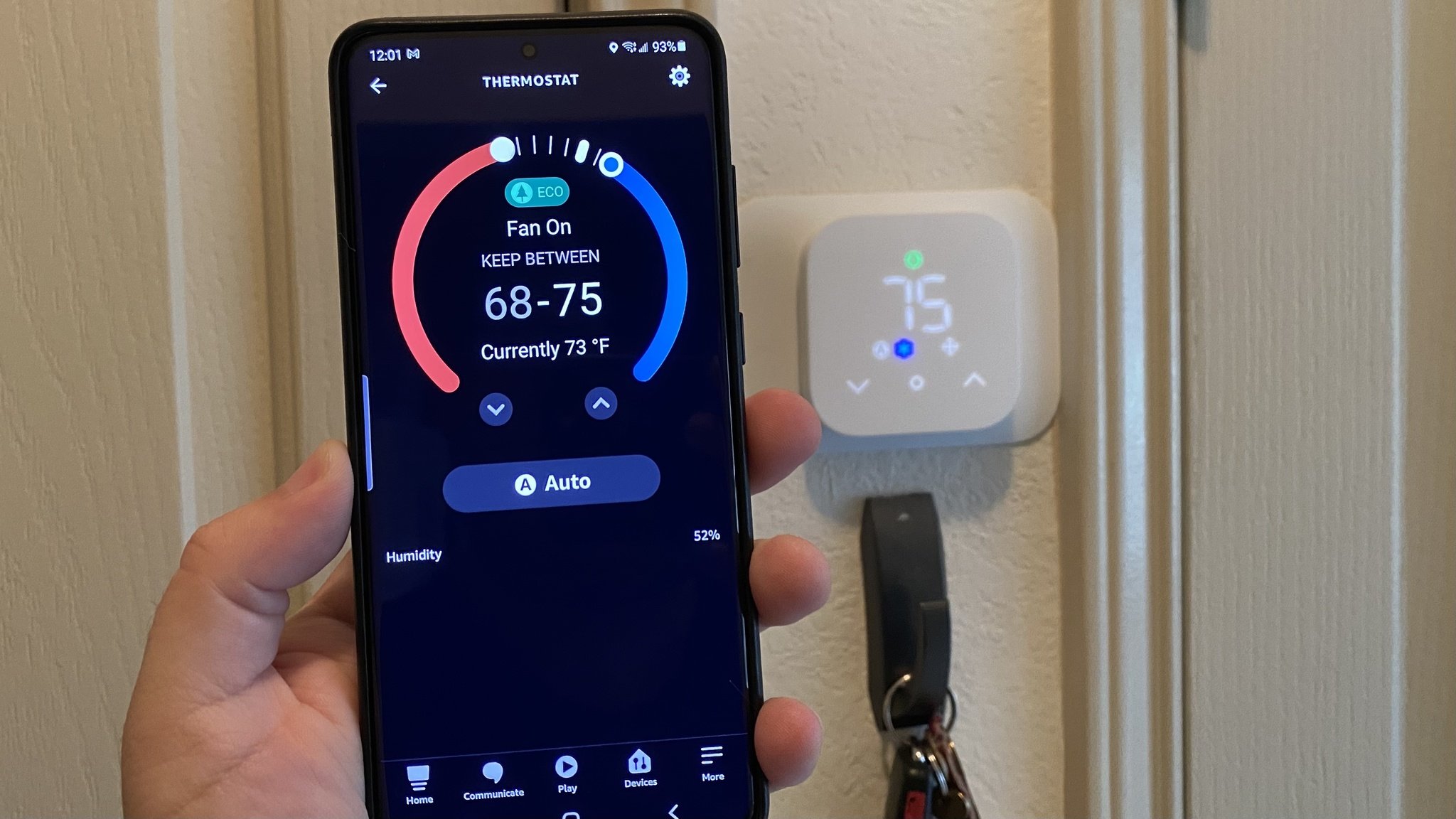Introduction
With the advancement in technology, smart home devices have become increasingly popular, making our lives more convenient and efficient. One such device is the smart thermostat, which allows homeowners to control their heating and cooling systems remotely. Among the various smart thermostats available on the market, the Nest E Smart Thermostat stands out with its “No Hub Required” feature.
A smart thermostat is a device that connects to your home’s heating and cooling systems, allowing you to remotely control and monitor its settings through a mobile app or a web interface. These intelligent devices offer a range of features, such as programming schedules, learning behaviors, and energy-saving modes to optimize home comfort and reduce energy consumption.
However, one common requirement for many smart home devices is the need for a separate hub or bridge that acts as a central control point for all the connected devices. This hub usually connects to your home’s Wi-Fi network and facilitates communication between the devices and the mobile app or web interface. However, the Nest E Smart Thermostat eliminates the need for a hub with its “No Hub Required” feature.
The “No Hub Required” feature means that the Nest E Smart Thermostat operates independently, without the need for an additional hub or bridge. This not only simplifies the installation process but also reduces the number of devices and cables required, making it a more streamlined and user-friendly option.
In this article, we will explore the significance of the “No Hub Required” feature in the Nest E Smart Thermostat. We will discuss how traditional smart thermostats work, the benefits of the “No Hub Required” feature, the easy installation process, compatibility with other devices, cost savings, and any limitations or considerations to keep in mind.
What is a smart thermostat?
A smart thermostat is an innovative device that revolutionizes the way we control and manage the heating and cooling systems in our homes. It is designed to provide homeowners with enhanced control and convenience, while also reducing energy consumption and saving money on utility bills.
Unlike traditional thermostats that require manual adjustment to set the desired temperature, smart thermostats offer advanced features and connectivity options. They can be connected to your home Wi-Fi network and controlled remotely through a mobile app or a web interface.
Smart thermostats come equipped with a variety of features that make them more intelligent and efficient compared to their traditional counterparts. One of the key features is the ability to create custom schedules, allowing you to program different temperature settings throughout the day based on your preferences and lifestyle.
Moreover, smart thermostats have learning capabilities. They can analyze your heating and cooling patterns and make automatic adjustments to optimize energy efficiency. They can adapt to your behaviors and preferences over time, creating a comfortable environment while minimizing unnecessary energy usage.
Another significant advantage of smart thermostats is their compatibility with voice assistants, such as Amazon Alexa and Google Assistant. This integration enables you to control your thermostat using voice commands, further enhancing convenience and accessibility.
Smart thermostats also provide valuable insights and data about your energy usage. They can generate reports that show your heating and cooling patterns, energy consumption, and savings. This information can help you make informed decisions and take steps to reduce your energy footprint.
Overall, smart thermostats offer a range of benefits, including improved control, energy efficiency, cost savings, and enhanced convenience. They provide homeowners with the ability to manage their heating and cooling systems from anywhere, at any time, and make adjustments to optimize comfort and energy usage.
What does “No Hub Required” mean?
The term “No Hub Required” refers to a feature found in certain smart home devices, including the Nest E Smart Thermostat. In the context of smart thermostats, it signifies that the device can operate independently, without the need for an additional hub or bridge.
Typically, smart home devices require a central hub or bridge that acts as a communication hub between the devices and the mobile app or web interface. This hub connects to your home’s Wi-Fi network and facilitates the exchange of information and commands between the devices and your smartphone or computer.
However, with the “No Hub Required” feature, the Nest E Smart Thermostat eliminates the need for this additional hub. It is designed to connect directly to your home’s Wi-Fi network, allowing you to control and monitor it using the Nest mobile app or web interface.
By removing the necessity for a hub, the Nest E Smart Thermostat simplifies the installation process, reduces the number of devices required, and minimizes the complexity of the setup. This makes it more user-friendly, particularly for those who are new to smart home technology or prefer a hassle-free installation.
The “No Hub Required” feature also provides greater flexibility and convenience. Since the Nest E Smart Thermostat is directly connected to your home’s Wi-Fi network, you can control and adjust the thermostat settings from anywhere using your mobile device or computer. This allows you to easily manage and monitor your home’s temperature, whether you’re at home, at work, or on the go.
Furthermore, not requiring a hub makes the Nest E Smart Thermostat more cost-effective. You don’t have to invest in an additional device, eliminating the associated cost and avoiding the hassle of setting up and maintaining the hub. It also means you have one less device to worry about, simplifying the overall ecosystem of your smart home.
Overall, the “No Hub Required” feature in the Nest E Smart Thermostat offers a seamless and hassle-free experience. It allows you to connect, control, and monitor your thermostat directly through your home’s Wi-Fi network, without the need for an additional hub or bridge.
How does a traditional smart thermostat work?
A traditional smart thermostat operates by connecting to your home’s heating and cooling systems and providing advanced control and scheduling options. While the specific features and functionalities may vary between different models, the fundamental operation of a traditional smart thermostat involves the following steps:
1. Sensing and monitoring: A traditional smart thermostat includes built-in sensors to measure the temperature of the surrounding environment. These sensors detect the current temperature and relay the information to the thermostat’s control unit.
2. User input: Users can manually adjust the desired temperature on the thermostat itself or through a connected mobile app or web interface. This input informs the thermostat about the preferred comfort level.
3. Feedback loop: The thermostat’s control unit uses the temperature readings from the sensors to compare them with the user-set desired temperature. If there is a difference between the actual temperature and the desired temperature, the thermostat initiates the appropriate action to adjust the heating or cooling output of your HVAC system.
4. Controlling the HVAC system: Based on the temperature readings and user input, the traditional smart thermostat sends signals to the heating and cooling systems, instructing them to turn on, off, or adjust their output. This ensures that the desired temperature is reached and maintained.
5. Programming and scheduling: Traditional smart thermostats offer advanced programming and scheduling options. Users can create custom schedules to automatically adjust the temperature settings at different times of the day or on specific days of the week. This allows for energy-efficient operation and personalized comfort.
6. Connectivity and remote control: Many traditional smart thermostats are equipped with Wi-Fi connectivity, enabling users to control and monitor their thermostat remotely through a mobile app or web interface. This feature enables homeowners to make adjustments and access thermostat settings from anywhere, enhancing convenience and flexibility.
Traditional smart thermostats often learn from user behavior and adapt to specific preferences over time. They can optimize temperature settings based on occupancy patterns and can also take into account factors such as outdoor weather conditions to further enhance energy efficiency.
While traditional smart thermostats offer advanced features and control, it’s important to note that they typically require an additional hub or bridge to connect and communicate with the other smart home devices. However, with the “No Hub Required” feature, the Nest E Smart Thermostat sets itself apart by eliminating the need for a separate hub and simplifying the overall installation process.
Benefits of the “No Hub Required” feature
The “No Hub Required” feature in the Nest E Smart Thermostat offers several advantages and benefits to homeowners. By eliminating the need for an additional hub or bridge, this feature simplifies the installation process and improves overall user experience. Let’s explore the benefits of the “No Hub Required” feature:
1. Streamlined installation process: With the “No Hub Required” feature, setting up the Nest E Smart Thermostat is much simpler and more straightforward. You don’t need to worry about purchasing and configuring a separate hub or bridge to connect the thermostat to your home’s Wi-Fi network. This convenience saves time and effort, especially for those who are not familiar with setting up complex smart home systems.
2. Reduced complexity: The “No Hub Required” feature reduces the number of devices and cables needed for your smart home setup. Without the need for an additional hub, your smart home ecosystem becomes more streamlined and less cluttered. This not only looks neater but also makes troubleshooting and maintenance easier.
3. Enhanced user-friendliness: The absence of a hub makes the Nest E Smart Thermostat more user-friendly, especially for beginners or individuals less familiar with smart home technology. The simplified installation and setup process, along with the intuitive user interface of the Nest app or web interface, allow for a seamless and straightforward experience.
4. Remote control and accessibility: The “No Hub Required” feature enables you to control your Nest E Smart Thermostat from anywhere, as long as you have an internet connection. Using the Nest app or web interface, you can adjust temperature settings, schedule changes, and monitor energy usage, providing you with convenience and flexibility. Whether you’re at home, at work, or on vacation, you can maintain control over your home’s temperature and optimize energy savings.
5. Compatibility with other devices: Despite not requiring a separate hub, the Nest E Smart Thermostat remains compatible with other smart home devices and platforms. It can integrate seamlessly with voice assistants like Amazon Alexa and Google Assistant, as well as other smart home systems. This allows for a cohesive and interconnected smart home environment, enabling you to control multiple devices through a single interface.
6. Cost-effectiveness: The “No Hub Required” feature eliminates the need to purchase an additional hub or bridge for your smart home setup. This can result in cost savings, making the Nest E Smart Thermostat a more affordable option compared to other smart thermostats that necessitate a hub. Additionally, it reduces the overall maintenance and replacement costs associated with an extra device.
Overall, the “No Hub Required” feature in the Nest E Smart Thermostat simplifies installation, enhances user-friendliness, and offers remote control capabilities without sacrificing compatibility or functionality. It provides homeowners with a convenient and cost-effective solution for managing their home’s temperature and energy usage.
Easy installation process
The Nest E Smart Thermostat offers an incredibly easy installation process, thanks to its “No Hub Required” feature. Whether you’re a seasoned DIY enthusiast or a beginner, setting up the Nest E Smart Thermostat can be accomplished with minimal effort and technical knowledge.
Here’s a step-by-step guide to installing the Nest E Smart Thermostat:
1. Turn off the power: Before you begin the installation process, ensure that the power to your HVAC system is turned off. This is crucial to prevent any electrical accidents during the installation.
2. Remove the old thermostat: Carefully remove the existing thermostat from the wall. Disconnect the wiring from the terminals and take note of the labels associated with each wire. This will help you correctly connect the wires to the Nest E Thermostat later.
3. Install the Nest E base: Attach the Nest E base plate to the wall using the provided screws. Make sure it is level and securely fastened. The base plate serves as the mounting point for the Nest E Thermostat.
4. Connect the wiring: Take the labeled wires from your old thermostat and connect them to the corresponding terminals on the Nest E base plate. The Nest E Thermostat comes with a built-in screwless wiring terminal, making it easy to secure the wires without the need for any tools.
5. Attach the Nest E display: Gently snap the Nest E display onto the base plate, ensuring it is aligned properly. The display will communicate wirelessly with the base plate, providing you with access to the thermostat’s settings and controls.
6. Configure the Nest E Thermostat: Once the Nest E Thermostat is installed, you can follow the on-screen prompts to configure the device. This includes connecting it to your home’s Wi-Fi network and setting up your preferences, such as temperature thresholds and scheduling options. The intuitive interface of the Nest app or web interface makes the configuration process quick and straightforward.
7. Power on and test: After completing the configuration, restore the power to your HVAC system. The Nest E Thermostat should turn on and display the current temperature. Test the heating and cooling systems to ensure the thermostat is functioning correctly.
That’s it! The Nest E Smart Thermostat is now successfully installed and ready to use. The simplified installation process, along with the user-friendly configuration interface, makes it accessible to users of all levels of technical expertise.
It’s worth mentioning that every home’s HVAC system and wiring may vary, so it’s essential to carefully follow the installation instructions provided by Nest. If you’re unsure or uncomfortable with the installation process, it’s recommended to seek professional assistance to ensure a safe and accurate installation.
The easy installation process of the Nest E Smart Thermostat, made possible by the “No Hub Required” feature, allows homeowners to quickly and effortlessly upgrade their homes with a smart and energy-efficient thermostat.
Compatibility with other devices
The Nest E Smart Thermostat is designed to be compatible with a wide range of other smart home devices and platforms, offering homeowners a seamless and integrated smart home experience. This compatibility allows for increased convenience, automation, and control over various aspects of your home. Let’s explore the compatibility features of the Nest E Smart Thermostat:
1. Voice assistants: The Nest E Smart Thermostat works harmoniously with popular voice assistants such as Amazon Alexa and Google Assistant. This integration enables you to control and adjust your thermostat using voice commands, adding an extra layer of convenience and accessibility to your smart home. Whether you want to change the temperature, adjust the schedule, or inquire about the current temperature, you can simply speak your commands to your preferred voice assistant.
2. Smart home platforms: The Nest E Smart Thermostat is compatible with various smart home platforms, allowing you to integrate it with other smart devices in your home seamlessly. It can connect with platforms like Apple HomeKit, Samsung SmartThings, and IFTTT (If This Then That), allowing you to create automation scenarios and customize interactions between your smart devices. For example, you can create a scene that automatically adjusts the temperature when you leave or arrive home, or synchronize your thermostat with other devices like smart lights or locks to enhance energy efficiency and home security.
3. Energy usage monitoring: The Nest E Smart Thermostat provides detailed insights and reports on your energy usage, allowing you to track and analyze your HVAC system’s performance. Additionally, it can connect with energy monitoring platforms or tools, giving you the ability to view your energy consumption in real-time and identify areas where you can further optimize energy efficiency.
4. Integration with smart home ecosystems: The “No Hub Required” feature of the Nest E Smart Thermostat ensures that it can be seamlessly integrated into existing or future smart home ecosystems. Whether you have a robust smart home setup or are just starting to explore smart technology, the Nest E Smart Thermostat can enhance your smart home experience without requiring additional hardware or complex configuration.
By being compatible with various voice assistants, smart home platforms, and energy monitoring tools, the Nest E Smart Thermostat gives you the flexibility to control and monitor your home’s temperature in a way that suits your individual needs and preferences. It allows you to create a customized and interconnected smart home environment, granting you increased convenience, energy efficiency, and comfort.
Before integrating the Nest E Smart Thermostat with other devices or platforms, it’s important to check the compatibility requirements and instructions provided by Nest. This ensures that you can seamlessly connect and control all your smart home devices, optimizing the benefits of a connected ecosystem.
The compatibility of the Nest E Smart Thermostat with other devices and platforms expands the possibilities and functionality of your smart home, making it easier to customize and personalize your home’s comfort and efficiency.
Cost savings with “No Hub Required”
The “No Hub Required” feature in the Nest E Smart Thermostat not only offers convenience and simplicity but also provides potential cost savings for homeowners. By eliminating the need for an additional hub or bridge, the Nest E Smart Thermostat becomes a cost-effective choice compared to other smart thermostats that require such devices. Let’s explore the potential cost savings associated with the “No Hub Required” feature:
1. Reduced device cost: Traditional smart thermostats typically require an additional hub or bridge to connect to your home’s Wi-Fi network. By eliminating the need for this extra device, the Nest E Smart Thermostat allows you to save money on the initial purchase cost. You can enjoy the benefits of a smart thermostat without the added expense of an additional hub, making it a more budget-friendly option.
2. Lower maintenance and replacement costs: With the “No Hub Required” feature, you have one less device to maintain and potentially replace. The absence of a separate hub reduces the complexity of your smart home setup, minimizing the chances of technical issues and the need for troubleshooting or repairs. This can result in long-term cost savings as you won’t have to invest in maintenance or replacement costs for an additional device.
3. Energy savings: One of the core benefits of a smart thermostat like the Nest E is its ability to optimize energy usage and reduce utility bills. With features like programmable schedules, learning capabilities, and remote control, the Nest E Smart Thermostat can help you create energy-efficient heating and cooling patterns tailored to your lifestyle. By efficiently managing your HVAC system, you can significantly reduce energy consumption and lower your monthly energy bills.
4. Rebates and incentives: Many energy providers and government agencies offer rebates and incentives for installing energy-saving smart thermostats. By choosing the Nest E Smart Thermostat with its “No Hub Required” feature, you may qualify for these incentives and receive additional cost savings. It’s always worth checking with your local energy provider or government programs to see if you’re eligible for any such benefits.
5. Long-term cost benefits: While the initial cost savings may be the most apparent benefit, the long-term cost benefits of the Nest E Smart Thermostat with “No Hub Required” extend beyond the initial purchase. The energy savings achieved through optimized heating and cooling patterns can add up significantly over time. By reducing energy waste and aligning temperature settings with your occupancy and preferences, you can potentially enjoy substantial savings on your utility bills year after year.
It’s important to note that while the “No Hub Required” feature provides cost savings in terms of device costs and potential energy savings, the overall savings will vary depending on factors such as your home’s energy usage, climate, and current heating and cooling systems. However, the combination of the cost savings associated with the Nest E Smart Thermostat’s “No Hub Required” feature and its energy-saving capabilities make it an attractive option for smart home enthusiasts looking to lower expenses and reduce environmental impact.
By choosing the Nest E Smart Thermostat with its “No Hub Required” feature, homeowners can enjoy both the convenience of a smart thermostat and the potential for long-term cost savings on device costs, maintenance, and energy consumption.
Limitations and considerations
While the Nest E Smart Thermostat with its “No Hub Required” feature offers numerous benefits, it’s important to consider some limitations and factors before making a purchasing decision. Understanding these limitations can help you set realistic expectations and ensure the smart thermostat meets your specific needs. Here are some key considerations:
1. Compatibility with HVAC systems: Before purchasing the Nest E Smart Thermostat, it’s crucial to check its compatibility with your home’s heating and cooling systems. While the Nest E is compatible with most HVAC systems, including gas, electric, and radiant heating systems, it may not be compatible with every system. Ensure that your HVAC system is compatible to avoid any installation complications or potential issues in controlling your heating and cooling systems.
2. Wi-Fi network stability: The Nest E Smart Thermostat relies on a stable Wi-Fi network connection for remote control and access. Consider the strength and reliability of your Wi-Fi network to ensure seamless operation of the smart thermostat. If your Wi-Fi connection is unstable or prone to frequent disruptions, it might impact the performance and accessibility of the Nest E Thermostat.
3. Professional installation: While the Nest E Smart Thermostat is designed for easy installation by homeowners, some individuals may prefer or require professional installation. If you are unsure about the installation process or have a complex HVAC system, it’s recommended to seek professional assistance to ensure proper setup and functionality.
4. Limited hardware features: Compared to higher-end smart thermostats, the Nest E Smart Thermostat has some hardware limitations. It has a simpler display and lacks features like touch-sensitive controls or enhanced display resolution. If you prioritize advanced hardware capabilities, you may consider higher-end models like the Nest Learning Thermostat, which offer additional features but may come at a higher cost.
5. Privacy and data considerations: As with any smart home device, data privacy is an important consideration. The Nest E Smart Thermostat collects and analyzes data about your energy usage and home temperature patterns to optimize its performance. Ensure that you review and understand the privacy policy and data collection practices of the Nest E Thermostat, and consider whether you are comfortable sharing your data with the manufacturer.
6. Mobile app dependency: While the remote control and accessibility of the Nest E Smart Thermostat through the mobile app are convenient, it also means that you are dependent on the app for control and monitoring. Ensure that you have a compatible smartphone or tablet, and consider whether you are comfortable relying on the app for controlling your thermostat, as unforeseen technical issues with the app or device can impact your ability to make adjustments remotely.
It’s important to thoroughly research and evaluate these limitations and considerations in the context of your specific requirements and preferences. Understanding how the Nest E Smart Thermostat aligns with your home’s heating and cooling systems, network infrastructure, and privacy concerns will help you make an informed decision and ensure a smooth experience with the device.
By considering these limitations and taking them into account, you can effectively gauge whether the Nest E Smart Thermostat meets your expectations and needs, and make a well-informed decision regarding the integration of this smart thermostat into your home.
Conclusion
The Nest E Smart Thermostat with its “No Hub Required” feature offers a user-friendly, cost-effective, and energy-efficient solution for controlling and monitoring the temperature in your home. By eliminating the need for an additional hub or bridge, the Nest E Smart Thermostat simplifies the installation process and reduces the complexity of your smart home ecosystem.
With its easy installation process, the Nest E Smart Thermostat can be seamlessly integrated into your home, allowing you to control and adjust the temperature from anywhere at any time. Its compatibility with voice assistants and other smart home platforms further enhances convenience and interconnectivity.
The “No Hub Required” feature provides potential cost savings by eliminating the need for a separate hub, reducing maintenance and replacement costs, and optimizing energy usage. Through programmable schedules, learning capabilities, and remote control, the Nest E Smart Thermostat helps you achieve energy efficiency and lower your utility bills.
However, it’s important to consider some limitations and factors, including compatibility with HVAC systems, Wi-Fi network stability, and privacy concerns. Understanding these considerations will help you set realistic expectations and ensure the Nest E Smart Thermostat meets your specific needs and preferences.
In conclusion, the Nest E Smart Thermostat with its “No Hub Required” feature is a smart and cost-effective choice for homeowners looking to enhance their comfort, energy efficiency, and convenience. Its easy installation, compatibility with various devices and platforms, and potential cost savings make it an attractive option for creating a more connected and sustainable home environment. By choosing the Nest E Smart Thermostat, you can enjoy the benefits of intelligent temperature control without the complexity and additional costs of a separate hub.









